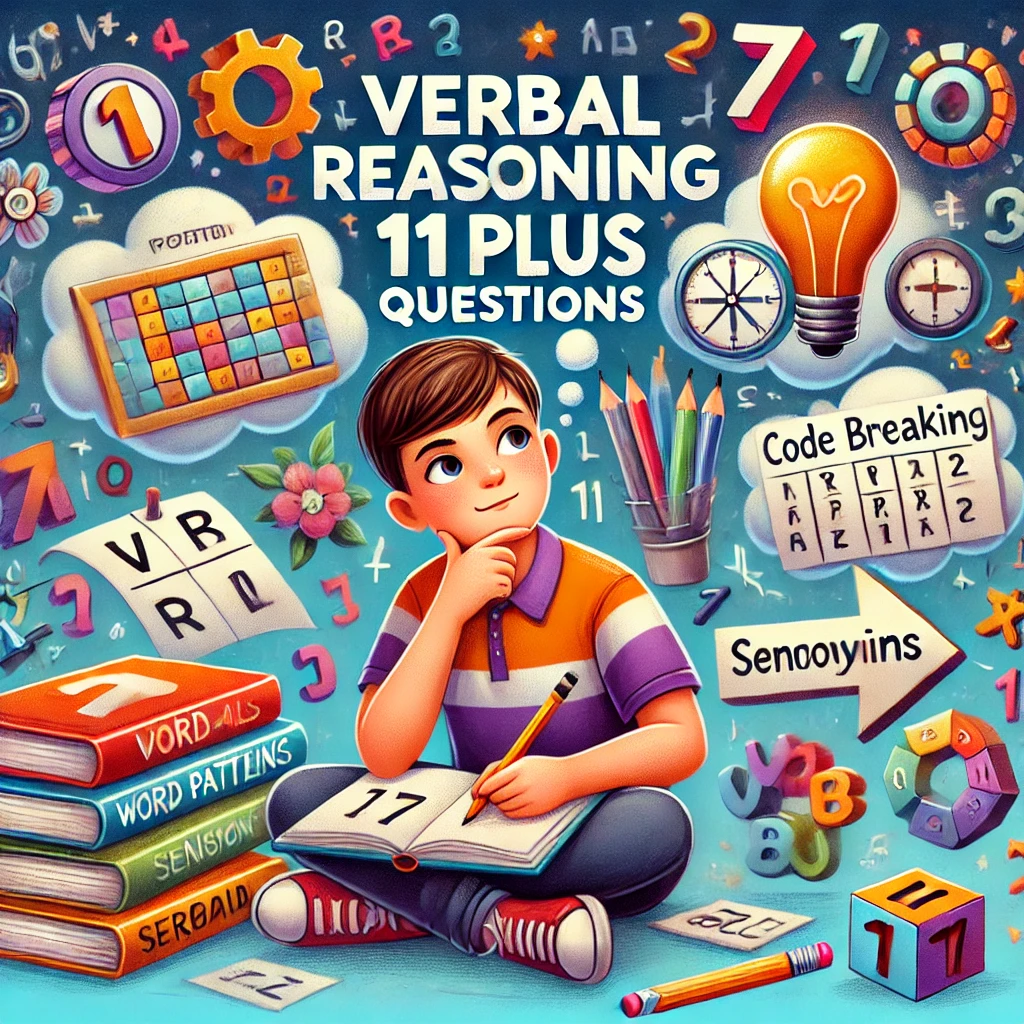The 11 Plus exam is a crucial step for students aspiring to attend grammar schools. This guide is designed to help parents and students understand the types of questions they will face, including Maths, English, Verbal Reasoning, and Non-Verbal Reasoning. By breaking down each section and providing practical tips, this guide aims to make the preparation process more manageable and effective. Whether you’re just starting or looking to refine your strategy, this ultimate guide will equip you with the tools needed to succeed in the 11 Plus exam.
11 Plus Subjects Overview
The 11 Plus exam assesses a range of skills across four key subjects: Maths, English, Verbal Reasoning, and Non-Verbal Reasoning. Each subject is designed to evaluate different aspects of a student’s cognitive abilities and academic knowledge. Understanding the structure of 11 Plus questions in these subjects is essential for effective preparation.
11 Plus Subjects
| Subject | Description | Example 11 Plus Questions |
| Maths | Focuses on arithmetic, geometry, and problem-solving. Tests understanding of Key Stage 2 topics and ability to apply mathematical concepts in different scenarios. | Arithmetic, fractions, geometry, word problems. |
| English | Assesses grammar, punctuation, vocabulary, and comprehension skills. Aims to evaluate a student's command of the English language and their ability to understand texts. | Grammar correction, reading comprehension, synonyms and antonyms. |
| Verbal Reasoning | Tests the ability to identify patterns, relationships between words, and logical reasoning using language-based questions. | Word patterns, logic puzzles, vocabulary-based questions. |
| Non-Verbal Reasoning | Evaluates spatial awareness and logical thinking using shapes and patterns. Requires students to solve visual puzzles and sequences. | Shape sequences, pattern recognition, spatial reasoning. |
11 Plus Questions Overview
The 11 Plus exam features a variety of question types across its four subjects: Maths, English, Verbal Reasoning, and Non-Verbal Reasoning. These questions are designed to assess not only academic knowledge but also a student’s problem-solving abilities, logical thinking, and comprehension skills.
- Maths Questions: Include arithmetic, geometry, and word problems, often requiring quick calculations.
- English Questions: Focus on grammar, punctuation, comprehension, and vocabulary.
- Verbal Reasoning Questions: Test logical deductions and word patterns.
- Non-Verbal Reasoning Questions: Involve shape sequences, spatial awareness, and logic puzzles.
Maths Questions

Maths questions in the 11 Plus exam are designed to test a student’s understanding of Key Stage 2 concepts and their ability to apply these concepts in problem-solving situations. The questions can range from basic arithmetic to more complex topics like geometry, fractions, and word problems.
Here are some common types of 11 Plus Maths questions:
- Arithmetic: Basic operations (addition, subtraction, multiplication, division).
- Geometry: Calculating area, perimeter, and volume of shapes.
- Fractions and Decimals: Converting between fractions, decimals, and percentages.
- Word Problems: Multi-step problems that require logical reasoning.
Example Question:
Arithmetic: Basic Operations
Addition: Add 567 and 234
Answer: 801.
Subtraction: Subtract 456 from 789.
Answer: 333
Multiplication: Multiply 42 by 9.
Answer: 378
Division: Divide 528 by 12.
Answer: 44
Mixed Operations: Calculate: (25 + 15) × 3 – 18 ÷ 2.
Answer: 108
Geometry: Area, Perimeter, Volume
Perimeter: Find the perimeter of a rectangle with length 8 cm and width 5 cm.
Answer: 26 cm
Area: What is the area of a triangle with base 10 cm and height 8 cm?
Answer: 40 cm²
Volume: Calculate the volume of a cube with side length 4 cm.
Answer: 64 cm³
Circle: Find the circumference of a circle with a diameter of 10 cm (use π = 3.14).
Answer: 31.4 cm.
Fractions and Decimals
Addition of Fractions: What is 3/4 + 1/2?
Answer: 5/4 or 1 1/4
Subtraction of Decimals: Subtract 0.45 from 1.2.
Answer: 0.75
Fraction to Percentage: Convert 3/8 to a percentage.
Answer: 37.5%
Percentage to Decimal: Convert 65% to a decimal.
Answer: 0.65
Word Problems
Distance Problem: If a car travels 150 miles in 3 hours, what is its speed in miles per hour?
Answer: 50 mph
Money Problem: If a toy costs £45 and is on sale for 20% off, how much does it cost after the discount?
Answer: £36
Time Problem: A train leaves at 3:45 PM and takes 2 hours and 30 minutes to reach its destination. What time does it arrive?
Answer: 6:15 PM
Fraction Problem: A pizza is cut into 8 equal slices. If you eat 3 slices, what fraction of the pizza remains?
Answer: 5/8
Ratio Problem: The ratio of boys to girls in a class is 3:2. If there are 18 boys, how many girls are there?
Answer: 12 girls
English Questions

Preparing for the 11 Plus exam requires a strong command of English, as this section challenges students with a range of questions that assess their reading comprehension, vocabulary, grammar, and writing abilities. Success in this area comes from consistent practice, which helps students sharpen their skills in understanding complex texts, expanding their vocabulary, and articulating their thoughts with clarity and precision. Excelling in the English section is a key step towards achieving top marks in the 11 Plus English exam.
1. Grammar and Punctuation
- Sentence Correction: Identify and correct grammatical errors in a sentence.
- Punctuation: Insert the correct punctuation marks in a sentence.
- Tense: Correct the tense of a sentence.
- Subject-Verb Agreement: Identify and fix errors in subject-verb agreement.
- Pronouns: Correct the usage of pronouns in sentences.
2. Comprehension
- Literal Questions: Answer questions based on the explicit content of a passage.
- Inference Questions: Draw conclusions from the information provided in a passage.
- Author’s Intent: Identify the purpose or intent behind a passage.
- Character Analysis: Answer questions about the characters in a passage.
- Summary: Summarise a passage or paragraph.
3. Vocabulary
- Synonyms: Identify words with similar meanings.
- Antonyms: Find words with opposite meanings.
- Homophones: Identify and correct the misuse of homophones.
- Cloze Tests: Fill in the blanks with appropriate words.
- Contextual Vocabulary: Choose the correct word based on the context of the sentence.
4. Spelling
- Correct Spelling: Identify and correct spelling mistakes in words.
- Commonly Confused Words: Distinguish between words that are commonly confused (e.g., their/there/they’re).
5. Sentence Structure
- Jumbled Sentences: Rearrange words to form a correct sentence.
- Sentence Completion: Complete sentences with appropriate phrases or clauses.
6. Creative Writing (where applicable)
- Story Writing: Compose a short story based on a prompt.
- Descriptive Writing: Write a descriptive passage based on a given topic or image.
These question types are designed to assess a student’s proficiency in various aspects of English and their ability to apply their knowledge effectively during the 11 Plus exam.
Verbal Reasoning 11 Plus Questions

Verbal Reasoning in the 11 Plus exam tests a student’s ability to understand and reason using concepts framed in words. The questions are designed to assess logical thinking, problem-solving, and language skills.
Types of Verbal Reasoning Questions
- Word Relationships
- Analogies: Identifying relationships between word pairs (e.g., hot is to cold as wet is to dry).
- Synonyms and Antonyms: Finding words with similar or opposite meanings.
- Sequences
- Word Sequences: Completing sequences of words based on a pattern.
- Letter Sequences: Identifying the next letter in a sequence.
- Codes
- Letter and Number Codes: Decoding words or phrases based on a pattern of letters or numbers.
- Symbol Codes: Decoding symbols that represent letters or words.
- Logic and Deduction
- Logic Puzzles: Solving word-based puzzles using logical reasoning.
- Syllogisms: Deductive reasoning questions that involve drawing conclusions from two premises.
- Word Formation
- Anagrams: Rearranging letters to form words.
- Compound Words: Combining words to form a new word.
- Odd One Out
- Finding the Odd Word: Identifying the word that does not fit with the others in a group.
- Cloze Tests
- Sentence Completion: Filling in the blanks in sentences with appropriate words.
- Reading Information
- Passage Interpretation: Answering questions based on a short passage of text.
By mastering these Verbal Reasoning 11 Plus questions, students can develop the critical thinking and problem-solving skills needed to excel in the exam.
Non-Verbal Reasoning 11 Plus Questions

Non-Verbal Reasoning in the 11 Plus exam is designed to assess a student’s ability to interpret and manipulate visual information. It focuses on recognising patterns, spatial awareness, and logical thinking, all of which are essential for problem-solving.
Types of Non-Verbal Reasoning Questions:
- Shape Sequences
- Pattern Sequences: Identify the next shape in a sequence by analysing the pattern, such as rotations, reflections, or changes in size and shading.
- Missing Shapes: Determine the missing shape in a sequence by identifying the rule governing the pattern.
- Analogies
- Shape Analogies: These questions require finding relationships between pairs of shapes, similar to word analogies in verbal reasoning. For example, if a square is to a rectangle, then what is a triangle to?
- Classification
- Odd One Out: Select the shape that doesn’t fit in a group. This may involve analysing shapes by features like the number of sides, shading, or angles.
- Shape Grouping: Classify shapes based on shared attributes such as symmetry, angles, or patterns.
- Mirror and Reflection
- Symmetry: Identify symmetrical shapes or find the mirror image of a shape. This could involve horizontal, vertical, or diagonal symmetry.
- Reflection Puzzles: Determine how a shape would appear if reflected across a line.
- 3D Shapes and Spatial Awareness
- Cubes and Nets: Identify how a 2D net folds into a 3D shape, such as a cube. This may involve predicting the position of colours or patterns once folded.
- Rotations: Visualise and determine how a shape or object appears after being rotated, often requiring the student to mentally manipulate the shape in space.
- Matrices
- Matrix Patterns: Solve visual puzzles arranged in a grid (matrix). The student must find the pattern that governs the arrangement and select the shape that completes the grid. These can involve multiple changes in shape, size, or orientation.
- Hidden Shapes
- Embedded Figures: Find a specific shape hidden within a complex figure. This tests the student’s ability to pick out details from a larger, more complex image.
- Overlapping Shapes: Determine the shape formed when two or more shapes overlap.
- Spatial Reasoning
- Matching and Building Shapes: Students may be asked to match a 3D shape to a 2D representation or predict what a 3D object would look like from a different angle.
- Paper Folding: Predict how a folded piece of paper will appear when unfolded, especially with cuts or markings.
- Matrices
- Grid Completion: This involves completing a grid of shapes by recognising the patterns or rules that determine the relationship between the shapes in each row or column.
Tips for Mastering Non-Verbal Reasoning
- Practice Regularly: Familiarise yourself with different question types and regularly practice with sample papers.
- Focus on Patterns: Non-verbal reasoning is all about recognising patterns, so train your mind to spot subtle differences in shapes and sequences.
- Use Logic: While these questions rely on visual information, logical thinking is key. Break down complex patterns into simpler parts.
By thoroughly practising these Non-Verbal Reasoning 11 Plus questions, students can develop the visual and spatial skills necessary to succeed in the exam.
Conclusion
Navigating the world of 11 Plus questions can be a daunting task, but with the right guidance and resources, it becomes a manageable and rewarding journey. Whether you’re focusing on verbal reasoning, non-verbal reasoning, mathematics, or English, preparation is key to success.
If you’re looking for personalised support to help your child excel, consider partnering with Edumentors. Our experienced 11 Plus tutors from top UK universities are here to provide tailored guidance, ensuring your child is fully prepared for every aspect of the 11 Plus exams. Start your child’s journey to success with the expertise and dedication that Edumentors offers.
Ready to give your child the best chance at success? Explore our 11 Plus tutors today and take the first step towards achieving their educational goals.








